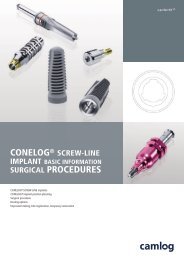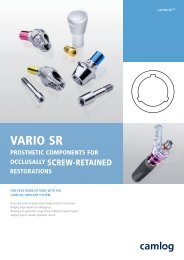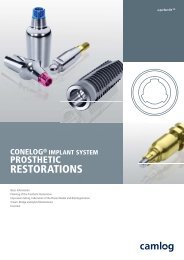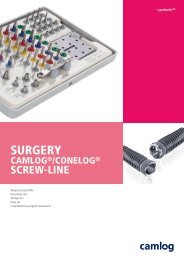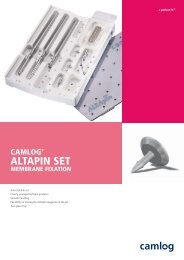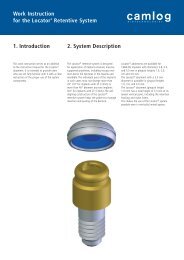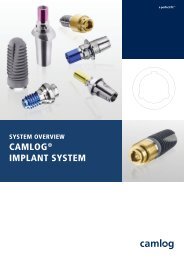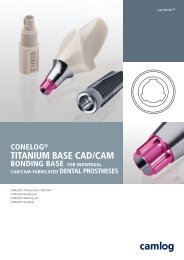Hybrid Restorations with the CAMLOG Implant System (PDF
Hybrid Restorations with the CAMLOG Implant System (PDF
Hybrid Restorations with the CAMLOG Implant System (PDF
Create successful ePaper yourself
Turn your PDF publications into a flip-book with our unique Google optimized e-Paper software.
DOUBLE CROWN<br />
RESTORATIONS<br />
INTRODUCTION<br />
For removable superstructures, we recommend inserting at least 6 implants<br />
in <strong>the</strong> maxilla and at least 4 implants in <strong>the</strong> mandible. The pros<strong>the</strong>sis design<br />
should prevent overloads by extensions. The tension-free seat of a secondary<br />
(double crown) or primary (bar) splinted structure on implants is called<br />
as "passive fit". With double crown constructions, this is obtained through<br />
intraoral bonding of <strong>the</strong> secondary copings (e.g. electroformed copings)<br />
to a tertiary framework. The tension-free seat of <strong>the</strong> superstructure is of<br />
paramount importance for <strong>the</strong> long-term prognosis of a pros<strong>the</strong>tic restoration.<br />
We recommend bonding secondary copings intraorally in <strong>the</strong> tertiary<br />
framework.<br />
PRODUCT DESCRIPTION<br />
The rotational stability of <strong>the</strong> <strong>CAMLOG</strong> ® Tube-in-Tube connection and<br />
high precision manufacturing make <strong>the</strong> <strong>CAMLOG</strong> ® abutments ideally<br />
suited for fabrication of double crown restorations. Two different methods<br />
are used for fabricating <strong>the</strong> secondary copings:<br />
• Electroformed secondary copings.<br />
• Cast secondary copings similar to <strong>the</strong> double crown technique.<br />
IMPRESSION TAKING AND CAST FABRICATION<br />
The impression for double crown restorations <strong>with</strong> <strong>CAMLOG</strong> ® universal,<br />
telescopic and gold-plastic abutments are taken <strong>with</strong> <strong>CAMLOG</strong> ® impression<br />
posts, open or closed tray.<br />
NOTE<br />
For double crown restorations <strong>with</strong> <strong>CAMLOG</strong> ® universal abutments PS,<br />
<strong>the</strong> impression is taken <strong>with</strong> <strong>CAMLOG</strong> ® impression posts PS, open or<br />
closed tray.<br />
For cast fabrication, <strong>CAMLOG</strong> ® lab analogs are used. For information about<br />
"Impression taking directly over <strong>the</strong> <strong>CAMLOG</strong> ® implant shoulder” and subsequent<br />
"Cast fabrication <strong>with</strong> <strong>the</strong> <strong>CAMLOG</strong> ® lab analog", see pages 12–15.<br />
HYBRID RESTORATIONS WITH THE <strong>CAMLOG</strong> ® IMPLANT SYSTEM<br />
CAST FABRICATION FOR MILLING TECHNIQUE<br />
For milling <strong>the</strong> <strong>CAMLOG</strong> ® abutments, we generally recommend creating a<br />
separate milling cast. The milling cast is fabricated by transferring <strong>the</strong><br />
<strong>CAMLOG</strong> ® lab analog positions from <strong>the</strong> working cast using <strong>CAMLOG</strong> ® impression<br />
posts, which are connected in a transfer construction <strong>with</strong> suitable<br />
acrylic. The construction is connected <strong>with</strong> acrylic in <strong>the</strong> retentive area of<br />
<strong>the</strong> impression posts. Acrylic must not get on <strong>the</strong> fixing screws.<br />
Working cast <strong>with</strong> <strong>CAMLOG</strong> ® lab<br />
analogs<br />
Placing <strong>the</strong> <strong>CAMLOG</strong> ® impression<br />
posts, open tray<br />
63




